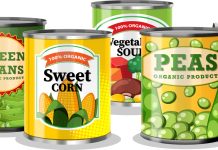 Use of proteins from vegetal sources is on the rise, due to increasing demand for healthy food, with low cholesterol and saturated fat which on the contrary are typically accompanying animal proteins. There are also economical reasons: vegetal sources of proteins are cheaper than meat.
Use of proteins from vegetal sources is on the rise, due to increasing demand for healthy food, with low cholesterol and saturated fat which on the contrary are typically accompanying animal proteins. There are also economical reasons: vegetal sources of proteins are cheaper than meat.
Among the food sectors where vegetal proteins are most used there is bakery: adding vegetal flours rich in proteins (e.g. from pulses) to ordinary cereal flours (e.g. wheat) has several advantages. First of all such bakery products will have additional nutritional value due to the essential amino acids typical of pulses but absent in cereals, creating a perfect combination which holds all the essential amino acids as animal protein sources provide. Furthermore, there are texture and structure improvement in the bakery product because protein rich flours tends to give a better leavening result, similar to that obtainable with gluten addition. Vegetal proteins addition also allows a dough stronger water retention power, with generally positive organoleptic outcome and a protective effect against staling during refrigeration and freezing. The substitution of 20-30%  of cereal flour with pulse flour is ideal; over this value, products softness and organoleptic characteristics (e.g. palatability) decrease. An important bakery range of products on its own right where pulse flours are widely used, is gluten-free products, for celiac customers. The presence of pulse proteins partially counteract the absence of gluten, the wheat and other cereals protein which most importantly contributes to structure and softness of leavened bakery products. Another special target food sector where protein rich flours are important ingredients is weight-loss products: consumption of protein rich foods seems to be linked to higher satiety sensation and easier slimming; because of this, several weight-loss regimes and “low-carb high proteins” slimming products lines have appeared, targeting overweight customers. Vegetal proteins are ideal for their formulation, leading to products perceived as healthier. Vegetal proteins also find wide applications in products targeting sportsmen, like protein rich snaks (e.g. cereals bars) to be consumed after training to improve muscular recovery and development. A part for bakery products, also other food sectors take advantage of vegetal proteins: a typical one is meat-substitution meals addressing vegan and vegetarian customer. In fact, vegetal proteins added as texturizers or bulking agents to vegetarian burgers or similar, allow to obtain a structure very close to real meat, with furthermore a good nutritional profile. Other special sectors where vegetal proteins play an important role are baby food (in particular formula milks for allergic subjects), milk substitutes for milk proteins allergic customers, and puff extruded snacks (where vegetal proteins give structure). Mostly used sources of vegetal proteins belong to the Fabaceae family (legumes, or pulses), characterized by their high protein content of their seeds: from 17 to 30% of fresh weight. Several products are available on the market: pulse flours (protein content not over 65%), concentrates (protein content above 65%), and isolates (protein content above 90%). Pulse protein show interesting chemical and textural characteristics which make them ideal as food ingredients: water solubility, both water and fat holding capacity, high nutritional value and easy to digest, and easy to be emulsioned. Among the most popular pulses used to obtain flours there are:
of cereal flour with pulse flour is ideal; over this value, products softness and organoleptic characteristics (e.g. palatability) decrease. An important bakery range of products on its own right where pulse flours are widely used, is gluten-free products, for celiac customers. The presence of pulse proteins partially counteract the absence of gluten, the wheat and other cereals protein which most importantly contributes to structure and softness of leavened bakery products. Another special target food sector where protein rich flours are important ingredients is weight-loss products: consumption of protein rich foods seems to be linked to higher satiety sensation and easier slimming; because of this, several weight-loss regimes and “low-carb high proteins” slimming products lines have appeared, targeting overweight customers. Vegetal proteins are ideal for their formulation, leading to products perceived as healthier. Vegetal proteins also find wide applications in products targeting sportsmen, like protein rich snaks (e.g. cereals bars) to be consumed after training to improve muscular recovery and development. A part for bakery products, also other food sectors take advantage of vegetal proteins: a typical one is meat-substitution meals addressing vegan and vegetarian customer. In fact, vegetal proteins added as texturizers or bulking agents to vegetarian burgers or similar, allow to obtain a structure very close to real meat, with furthermore a good nutritional profile. Other special sectors where vegetal proteins play an important role are baby food (in particular formula milks for allergic subjects), milk substitutes for milk proteins allergic customers, and puff extruded snacks (where vegetal proteins give structure). Mostly used sources of vegetal proteins belong to the Fabaceae family (legumes, or pulses), characterized by their high protein content of their seeds: from 17 to 30% of fresh weight. Several products are available on the market: pulse flours (protein content not over 65%), concentrates (protein content above 65%), and isolates (protein content above 90%). Pulse protein show interesting chemical and textural characteristics which make them ideal as food ingredients: water solubility, both water and fat holding capacity, high nutritional value and easy to digest, and easy to be emulsioned. Among the most popular pulses used to obtain flours there are:
– SOY (Glycine max). It is the typica vegetal protein source, both in human and animal nutrition: a great proportion of food products for vegetarian customers is soy based, including meat-resembling meals (burgers, “meat” balls, etc.). Soy seeds are rich in lipids and proteins, therefore used both for oil and protein rich flour extraction. For bakery applications, soy flour addition is linked to dough stabilization (in particular if a freezing stage is necessary) and slower staling. Nevertheless, soy use involves some problems: soy contains allergenic proteins to some subjects, therefore its presence needs to be clearly declared in every food product label; furthermore, genetically modified (GMO) soy varieties are widely used and at present GMO-free soy is hard to find for customers willing to do so.
– LUPIN (Lupinus sativus e albus). The seed of this plant is characterized not only by a very high protein content (higher than soy), but also by a high fibre content, with related health beneficial effects. A scientific study found that substituting 30% of wheat flour with lupin flour it is possible to improve protein and fibre content of baked products (e.g. muffins) without affecting taste, colour, flavour and texture. Furthermore, lupin is cheaper than other protein and fibre sources, e.g. wheat or oat bran.
 – PEA (Pisum sativum). Some extraction procedures, to obtain high purity proteins from this source, are patented. Pea proteins have are ideal to be used in emulsions and gels, and are able to hold both fat and water; therefore they can be used both in meat or fish based products as extenders, in quantities up to 10% without any organoleptic changes. Pea proteins are also ideal for the bakery sector because they allow better moisture holding capacity, improving products softness, and also for puff snacks, where their texturizing properties expand the mass during snack extrusion.
– PEA (Pisum sativum). Some extraction procedures, to obtain high purity proteins from this source, are patented. Pea proteins have are ideal to be used in emulsions and gels, and are able to hold both fat and water; therefore they can be used both in meat or fish based products as extenders, in quantities up to 10% without any organoleptic changes. Pea proteins are also ideal for the bakery sector because they allow better moisture holding capacity, improving products softness, and also for puff snacks, where their texturizing properties expand the mass during snack extrusion.
– PEANUT (Arachis hypogaea). Peanut flour have the indubitable advantage of giving to bakery products a pleasant flavour and taste, particularly familiar and appreciated in English-speaking Countries. Besides high protein content (40-50%), peanut flour is rich in fibres. The fat rich part of the seed is mostly eliminated before obtaining the flour and used to produce e.g. peanut oil or butter: just 12-28% of triglycerides are present in peanut flour, with an high proportion of unsaturated fatty acids and no cholesterol. Peanut flour is easily added to many different products formulation: bakery, confectionery, sauces, thick drinks, etc., without the unpleasant taste often caused by soy proteins. Unfortunately peanut has the same problem pointed out for soy: it is an allergen to be declared in the product label.
Other pulse flours sometimes used are bean (Phaseolus lunatus), chickpea (Cicer arientinum) and lentils (Lens culinaris), all of them available in several varieties.
Sources
J. Boye, F. Zare & A. Pletch, 2010. Pulse proteins: processing, characterization, functional properties and applications in food and feed. Food Research International, 43:414-431
D. Nilufer-Erdil, L. Serventi, D. Boyacioglu & Y. Vodovotz, 2012. Effect of soy milk powder addition on staling of soy bread. Food Chemistry, 131(4):1132-1139
A.L. Simmons, K.B. Smith & Y. Vodovotz, 2012. Soy ingredients stabilize bread dough during frozen storage. Journal of Cereal Science, 56(2):232-238
S.M. Nasar-Abbas & V. Jayasena, 2012. Effect of lupin flour in corporation on the physical and sensory properties of muffins. Quality Assurance and Safety of Crops & Foods
Pea protein application note, September 2011. www.pea-protein.com
Peanut flour trade information paper, October 2011. www.peanutusa.org.uk



